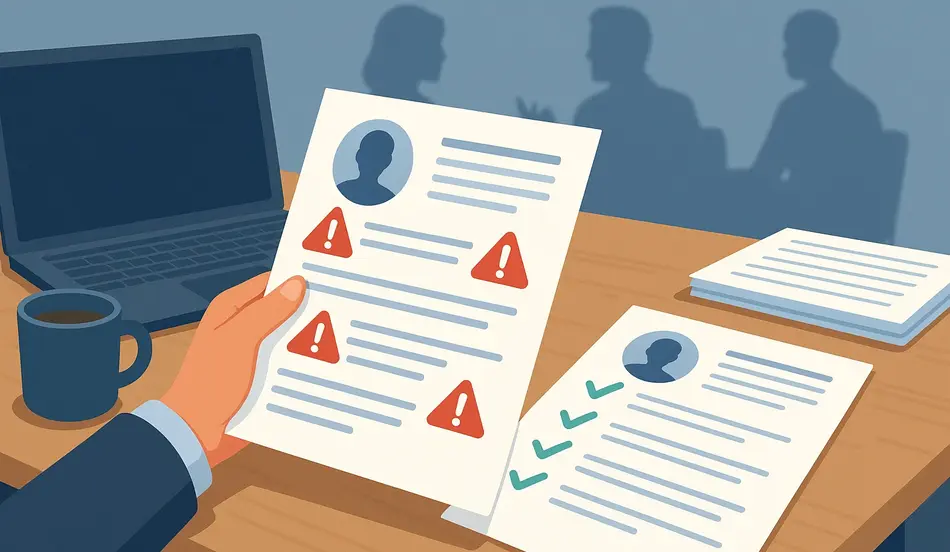Recruiters are busy people. On average, they spend just six to seven seconds scanning a resume before deciding whether it’s worth a closer look. In that brief window, certain mistakes—known as resume red flags—can instantly make a hiring manager question your professionalism, attention to detail, or overall suitability for the job.
The good news? Most of these red flags are avoidable. With careful editing and the right strategies, you can turn potential deal-breakers into opportunities to showcase your strengths.
This guide takes you through the top resume red flags recruiters notice immediately, explains why they matter, and gives you practical ways to fix them before your application hits “send.”
Why Resume Red Flags Matter
Recruiters see patterns quickly. If your resume has:
- unexplained gaps in employment,
- inconsistent dates,
- vague job descriptions, or
- formatting that’s hard to follow,
it triggers doubt. Even if you’re qualified, those doubts may keep your resume from moving forward.
In today’s competitive job market, the margin for error is slim. Fixing red flags not only keeps your resume out of the rejection pile but also shows you understand professional standards.
The Top Resume Red Flags (and How to Fix Them)
Below are the most common resume mistakes recruiters notice in seconds—and proven strategies to correct them.
1. Unexplained Employment Gaps
Why it’s a red flag: Recruiters may assume you were out of work due to performance issues or lack of commitment.
How to fix it:
- Be transparent. Add a one-line explanation such as “Career Break – Family Care (2022–2023)” or “Professional Development – Completed Data Analytics Certification (2021–2022).”
- Highlight productive activities like volunteering, freelance work, or coursework.
- Emphasize skills gained during that period if they are relevant to your target role.
2. Job Hopping Without Context
Why it’s a red flag: Multiple short stints (less than one year each) suggest instability or lack of loyalty.
How to fix it:
- Label contract or temporary work clearly. For example, “Contract Web Developer – XYZ Agency (6 months).”
- If roles ended due to mergers, relocations, or restructuring, mention that.
- Combine similar short-term roles into a single entry, such as “Freelance Designer (2019–2021).”
3. Generic or Overused Phrases
Why it’s a red flag: Recruiters skip past clichés like “hardworking team player” or “results-driven professional.” They provide no proof of ability.
How to fix it:
- Replace with concrete examples.
- Instead of “Strong leadership skills,” write “Led a 10-person cross-functional team that reduced production errors by 25%.”
- Use action verbs like spearheaded, implemented, achieved, streamlined.
- Whenever possible, quantify results with percentages, timeframes, or dollar amounts.
4. Typos and Grammar Mistakes
Why it’s a red flag: Errors show carelessness, which is unacceptable in most professional roles.
How to fix it:
- Run multiple spell checks but don’t rely on them alone.
- Read the resume out loud to catch awkward phrasing.
- Ask a trusted colleague or mentor to review your document.
5. Overly Long or Unfocused Resumes
Why it’s a red flag: Recruiters prefer concise resumes. A five-page document suggests poor communication skills or inability to prioritize.
How to fix it:
- Limit resumes to one page if you have less than 10 years of experience, or two pages if more.
- Focus on the last 10–15 years of employment.
- Trim irrelevant roles and details.
6. Missing Keywords for ATS Systems
Why it’s a red flag: Applicant Tracking Systems (ATS) scan resumes for keywords before recruiters even see them. If your resume lacks those words, it may never be reviewed by a human.
How to fix it:
- Study the job description and extract the most repeated or emphasized terms.
- Incorporate those terms naturally in your skills and work history sections.
- Avoid “keyword stuffing.” Make sure the words appear in meaningful context.
7. Inconsistent Dates or Job Titles
Why it’s a red flag: Inconsistencies can look like dishonesty or carelessness.
How to fix it:
- Use a consistent format, such as “Jan 2020 – May 2023.”
- Don’t invent creative job titles. Stick to standard ones recruiters recognize.
- Double-check alignment and spacing for accuracy.
8. Weak Formatting and Poor Design
Why it’s a red flag: Cluttered resumes, hard-to-read fonts, or strange design choices distract from your skills.
How to fix it:
- Use a clean, professional format with clear headings.
- Stick to fonts like Arial, Calibri, or Helvetica.
- Save as a PDF to maintain formatting unless instructed otherwise.
9. Listing Responsibilities Instead of Achievements
Why it’s a red flag: A resume that simply describes duties makes you look like every other applicant with the same role.
How to fix it:
- Replace duties with accomplishments.
- Example: Instead of “Managed social media accounts,” write “Increased engagement by 60% in six months through targeted campaigns.”
- Focus on results, not tasks.
10. Outdated or Irrelevant Information
Why it’s a red flag: Including old roles or irrelevant skills makes your resume look dated and unfocused.
How to fix it:
- Cut jobs older than 15 years unless directly relevant.
- Remove outdated technology (such as “MS-DOS” or “WordPerfect”).
- Keep certifications current and list only those applicable to your target job.
Other Common Red Flags Recruiters Notice
- Unprofessional email addresses (e.g., funnicknames@email.com).
- Including a headshot (standard in some countries but discouraged in the U.S.).
- Overuse of buzzwords without context.
- Large unexplained career shifts with no explanation.
How Recruiters Think When Spotting Red Flags
Recruiters rarely reject candidates for a single red flag. Instead, they look for patterns of concern. For example, one gap in employment is acceptable if explained, but multiple gaps, vague job titles, and formatting errors together form a negative impression.
By fixing red flags, you reduce doubt and make it easier for recruiters to focus on your qualifications.
Resume Red Flag Checklist
Before sending your resume, ask yourself:
- Does my resume clearly explain my career timeline?
- Have I replaced vague duties with measurable results?
- Is formatting clean, consistent, and professional?
- Do all dates and titles match across roles?
- Are keywords from the job description included?
- Have I removed irrelevant or outdated details?
- Did I proofread for typos and grammar mistakes?
Key Takeaway
A resume is more than a record of jobs—it’s a marketing tool. Recruiters don’t expect perfection, but they do expect clarity, professionalism, and relevance.
By removing red flags and presenting your achievements in a clean, results-driven format, you dramatically improve your chances of moving past the initial scan and into the interview stage.
Frequently Asked Questions (FAQs)
1. Should I explain every employment gap on my resume?
Not every small gap requires explanation, but anything longer than six months should be addressed. You don’t need to go into personal details—just add a short, professional note such as “Career Break – Professional Development” or “Family Care.”
2. Is it okay to leave older jobs off my resume?
Yes. Recruiters are mostly interested in the past 10–15 years of experience. Older jobs can be summarized in a short section called “Earlier Experience” or omitted entirely if not relevant.
3. How many jobs should I include on my resume?
Focus on your most recent and relevant positions, typically the last three to five roles. If you have many short-term contracts, group them under one heading such as “Freelance Projects.”
4. What’s the biggest resume red flag for recruiters?
The most damaging red flag is dishonesty. Inconsistent dates, inflated job titles, or fabricated achievements are easy to spot and can end your candidacy immediately. Always be accurate and truthful while highlighting your accomplishments.






